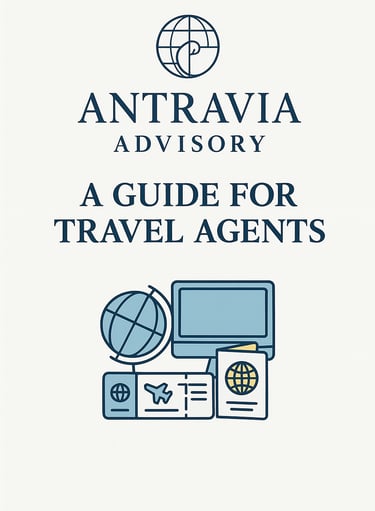
Travel Agent Finance Guide 2025: 4.5 Using Financial Reporting for Strategy
Part 4.5 of the Antravia Travel Agent Finance Guide - Learn how to use profit and loss, balance sheet, and cash flow together to guide strategy. Discover key metrics like revenue per booking, cancellation ratios, and client lifetime value to build a sustainable travel agency.
ANTRAVIA TRAVEL AGENT GUIDE
1/17/20257 min read


Part 4: Building Financial Resilience
In the next part of our Travel Agent Finance Guide, we move beyond day-to-day accounting and look at the bigger picture: how to build a financially resilient travel business. This section will cover how to plan for growth, manage working capital, and prepare for shocks such as supplier failures or sudden drops in demand. We will also address financing options, from credit lines to investor funding, and examine how to use financial reporting to guide long-term decisions. The goal is to give travel agents a framework for sustainability, so you can not only survive but thrive in a constantly shifting industry.
4.1 Forecasting and Planning for Growth
Why forward-looking cash flow forecasts are critical
Using booking patterns, seasonality, and pipeline data to anticipate revenue
Planning for expansion into new markets or niches
Setting aside reserves during strong months to cushion weaker periods
4.2 Working Capital and Liquidity Management
Understanding the timing gap between client deposits and supplier payments
Maintaining liquidity to cover chargebacks, refunds, or delayed commissions
Best practices for separating operating capital from client money
Using short-term reserves and credit responsibly
4.3 Financing Options for Travel Agents
Credit lines and small business loans: what banks actually look for
SBA loans and financing programs in the U.S.
Investor funding: when it makes sense, when it doesn’t
Host agency advances and supplier credit terms as hidden financing sources
Surviving the first years
4.4 Preparing for Industry Shocks
Supplier insolvency: how to protect clients and your own cash flow
Sudden demand drops (pandemics, geopolitical events, recessions)
Insurance strategies: business interruption, professional liability, cyber risk
Building flexibility into your cost base so you can adapt quickly
4.5 Using Financial Reporting for Strategy
How to use profit and loss, balance sheet, and cash flow together
Identifying trends: revenue per booking, cancellation ratios, client lifetime value
Moving from reactive to proactive decision-making
Using financial data to position your agency for long-term sustainability


Part 4.5 Using Financial Reporting for Strategy
Most travel agents think of financial reports as something for tax season. In reality, your profit and loss, balance sheet, and cash flow statement are not just compliance tools but are the foundation of strategy. When used correctly, they help you spot risks before they hit, identify which clients and trips are most profitable, and decide when to expand or hold back.
Moving beyond compliance
There is a difference between compliance reporting (produced for the tax authority) and management reporting (produced for you). Compliance reports show past facts, but management reports should guide decisions. A strategic agency produces monthly management accounts that are accurate, timely, and consistent.
Profit and Loss (P&L) – Measuring Performance
The profit and loss statement shows income and expenses over a period. For a travel agent, it must separate:
Gross sales (the full trip value) from net revenue (the commission or fees you actually earn). Recording gross sales as income is a common mistake.
Commissions receivable (commissions you’ve earned but not yet collected).
Service fees (flat planning fees or consulting fees that you charge clients directly).
A P&L tells you whether your agency is profitable, but it cannot explain cash timing. An agency can show profit while still running out of money and for that you need the other reports.
Balance Sheet – The Snapshot of Position
The balance sheet shows what you own and owe at a specific point in time. For travel agents, the critical lines are:
Unearned revenue (or client deposits) – money collected from clients for trips not yet delivered. This is a liability, because if the trip is cancelled you may owe it back.
Supplier payables – amounts owed to airlines, hotels, or DMCs. These often move faster than commissions are collected.
Commissions receivable – money owed to you by hosts or suppliers. This is an asset, but until collected it provides no cash.
These items are unique to travel and often ignored by bookkeepers unfamiliar with the sector. They matter because they show whether growth is funded by real profit or by unpaid commissions and client deposits.
Cash Flow Statement - "The Reality Check"
The cash flow statement tracks money in and out. It explains why profitable agencies still fail. In travel, the mismatch is routine:
Clients pay deposits now.
Suppliers must be paid before departure.
Commissions arrive weeks or months later.
A proper cash flow report maps these timings. It shows whether you will have the liquidity to survive slow supplier payments, sudden chargebacks, or refund surges. Also see How to manage cashflow as a Travel Agent.
Key Metrics to build into Reporting
Strategic reporting means looking past the headline profit to metrics that drive decisions:
Revenue per booking – Average commission or fee earned per trip. Rising values often mean a stronger client base; falling values can signal discounting or lower-value niches.
Leisure agents often target $300–$800 commission per trip. Corporate agencies may average less per booking but gain through volume and repeat CLV.
Cancellation ratio – The percentage of trips cancelled compared to those booked. A rising ratio is an early warning of demand instability or supplier issues. A healthy leisure agency keeps cancellations below 15%. Ratios consistently above 20% signal supplier or client issues and should trigger a forecast review.
Customer Lifetime Value (CLV) – The total commission and fees expected from a client over the entire relationship. For example, a family who books once with $500 commission has CLV = $500. A corporate client who books $5,000 a year for 10 years has CLV = $50,000. CLV guides how much you should invest in winning and keeping clients.
Client Acquisition Cost (CAC) – The marketing and sales spend required to win one new client. Comparing CAC to CLV tells you whether marketing spend is sustainable.
Customer Lifetime Value (CLV) vs Client Acquisition Cost (CAC) – A sustainable benchmark is at least a 3:1 ratio (every $1 spent to acquire a client should yield $3 in long-term value). Stronger agencies achieve 5:1 or more.
Cash Conversion Cycle – The time between paying suppliers and receiving cash from clients and commissions. A long cycle creates liquidity strain, even if profits look healthy. Agencies typically operate with 30–90 day cycles depending on supplier terms. Longer cycles put liquidity under pressure and make financing essential.
Unearned revenue coverage – Client deposits should always be fully backed by cash in the bank or trust account. A gap here is the single biggest red flag on a balance sheet.
Accounting Tie-Backs
P&L link – CAC is calculated by dividing marketing and sales expenses (from the P&L) by the number of new clients gained in that period.
Balance sheet link – CLV requires a client history, but the strength of receivables and unearned revenue lines shows whether your CLV is turning into cash or stuck in supplier pipelines.
Cash flow link – Cancellation ratios and refund activity flow directly into operating cash flow. High cancellations reduce forecasted inflows, and without a rolling cash forecast, liquidity squeezes arrive without warning.
Monthly management pack – Include a one-page “dashboard” alongside your standard three reports: bookings by value, cancellations, CLV vs CAC, and cash runway (months of fixed costs covered).
Case Examples
Case 1 – The Profit Illusion
A boutique agency showed $80,000 profit on its P&L. But the balance sheet revealed $60,000 in unearned revenue (client deposits not yet travelled) and $40,000 in supplier payables. Once cash flow was reviewed, it was clear the agency would need short-term financing to cover supplier bills until commissions arrived. Without reporting across all three statements, the owner might have mistaken paper profit for real cash.
Case 2 – Strategic Use of CLV
A corporate-focused agency calculated that each retained client generated $25,000 in commission over five years (CLV). Acquisition cost (CAC) per client was only $2,000 in marketing and sales expense. By running these numbers, the agency justified doubling its marketing budget and achieved 40% growth the next year. Without CLV and CAC analysis, they might have kept spending too cautiously and missed the opportunity.
From Reactive to Proactive
Agencies without structured reporting react only when cash runs low or when tax bills arrive. Agencies that embed financial reporting into strategy act before problems escalate. For example:
Rising cancellation ratios prompt adjustments to supplier commitments.
Falling revenue per booking triggers a review of niche focus.
High CAC compared to CLV forces a rethink of marketing tactics.
Long-Term Sustainability
Consistent reporting builds credibility with banks, hosts, and investors. It allows owners to evaluate expansion into new markets, assess when to hire staff, or decide whether to seek financing. Most importantly, it gives the owner confidence that the agency is not just surviving, but positioned to grow.




References for Part 4.5 Using Financial Reporting for Strategy
U.S. Small Business Administration – Financial Management for Small Businesses
https://www.sba.gov/business-guide/manage-your-business/manage-your-financesFederal Reserve – Small Business Credit Survey (for benchmarks on liquidity and financing)
https://www.fedsmallbusiness.org/surveyInvestopedia – Customer Acquisition Cost vs Customer Lifetime Value
https://www.investopedia.com/terms/c/customer-lifetime-value-clv.aspInternational Air Transport Association (IATA) – Travel Agency Risk and Financial Settlement Rules
https://www.iata.org/en/services/finance/agency-risk-managementIFRS Foundation – IAS 7: Cash Flow Statements (cash flow presentation requirements)
https://www.ifrs.org/issued-standards/list-of-standards/ias-7-statement-of-cash-flows/AccountingTools – Unearned Revenue in Travel Agencies
https://www.accountingtools.com/articles/unearned-revenue


Acknowledgements
Antravia would like to thank our consulting clients and industry partners who generously shared their time, insights, and real-world case studies. All client examples have been anonymized and edited for clarity, but they are based on true advisory engagements and reflect real decisions, challenges, and financial outcomes from across the travel industry.
Antravia Advisory
Where Travel Meets Smart Finance
Email:
Contact us:
Antravia LLC
© 2025. All rights reserved. | Disclaimer | Privacy Policy | Terms of Use | Accessibility Statement
Antravia.com - Global site of the Antravia Group.
Antravia.com | Antravia.co.uk | Antravia.ae |
Finance.travel | Tax.travel | Vat.travel |
USSales.tax | EuroVAT.tax | UKVAT.tax |
contact@antravia.com
Antravia LLC
4539 N 22nd St., Ste. N
Phoenix
Arizona
85016
